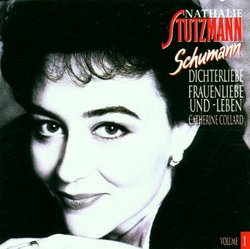| All Artists: Schumann, Stutzmann Title: Dichterliebe & Frauenliebe Members Wishing: 1 Total Copies: 0 Label: RCA Release Date: 5/11/1993 Genres: Pop, Classical Styles: Vocal Pop, Opera & Classical Vocal Number of Discs: 1 SwapaCD Credits: 1 UPC: 090266118724 |
Search - Schumann, Stutzmann :: Dichterliebe & Frauenliebe
CD Details |
CD ReviewsThe songs of Schumann's tragic life cycle Mr Bassil A MARDELLI | Riad El-SOLH , Beirut Lebanon | 04/17/2008 (5 out of 5 stars) "
This recording includes two main themes: Dichterliebe, 'The Poet's Love' - OP 48, and Frauenliebe und -Leben (A Woman's Love and Life) - OP 42, written in 1830. Each piece is a song cycle to poems by Kerner, Heine, Geibel, and Adelbert von Chamisso, ascribed to their composer as Songs of Robert Schumann. Op. 48 consists of many songs written by Heinrich Heine, which form an integral part of music literature. Schuman composed them in 1840 at the age of 30. Schumann's hard luck is very much embedded in these melodies. As if he was bemoaning his bad fortunes. Listen to them and judge for yourselves. Schumann had hoped to follow a career as a virtuoso pianist. He had great confidence in his piano teacher - Friedrich Wieck - (who later became his father in law). Schumann knew he could become the best pianist in Europe within a very short time of study with Wieck. However, a hand injury precluded his hopes from being realized, thus he decided to concentrate his natural musical gifts on composition. There are different and dissimilar versions concerning his `damaged' fingers. One due to a certain mechanical gimmick (or a surgical operation) that he used to strengthen his weakest fingers, another version tells us the trauma was actually caused by medications he took to cure the syphilis he came across during his student days and carried forward to his death bed. Until 1840, Schumann's published compositions were all consecrated for the piano; only later did he compose works for both piano and orchestra and many more songs for voice and piano. {Schumann also composed four symphonies, one opera, and other choral , orchestral and chamber works.} The year 1840 was Schumann's triumph over his teacher (and musical mentor) - Wieck - because he won bitter legal conflict and was then able to marry Friedrich's daughter, Clara. If Wieck was the piano tutor for Schumann, Heinrich Heine the author of the sarcastic poems and one of the notable writers on German Romanticism., was his main literalist. Heine's romanticism, for instance, is like depicting a sorrowful knight who spends all his night long hours sitting idly under the trees or huddled in his house yearning for a visit by his fairy bride, and contemplating dances with her until daylight comes to wake him up from that soothing dream. Dichterliebe OP 48 is a selection of such poems. The fanciful end of it is that the knight is going to put in a coffin all his old bad songs and dreams, all his anguished love and misery, and himself too, awaiting twelve giants to dump into the sea. ((Perhaps I should mention that Schumann himself was suicidal - more so such inclination grew stronger during the last two years of his life when the great composer was enclosed in a mental institution). How cruel !!! Frauenliebe und -Leben - A Woman's Love and Life OP 42- was written by Adelbert von Chamisso (1830) and drew the road map of a woman's love for her man. The lover woman explains to us how she felt from her first rendezvous with her `man' through their marriage until her husband's death. ((How far fate has put Clara Schumann in that situation after Robert's death)) "Since I Saw Him", "He, the Noblest of All", "I Cannot Grasp or Believe", "You Ring Upon My Finger", "Help Me, Sisters", "Sweet Friend, You Gaze", "At My Heart, At My Breast", and "Now You Have Caused Me Pain for the First Time". Some beautiful verses they are. Listen carefully to ""You, ring on my finger"" and notice Schumann's expressive lamentations for his own fingers, many of the texts are indeed inspired by his personal life. See how much the piano is set to be independent from the voice, like Schumann separating his soul away from an instrument that he loved and could master, save his obstacles. Notice how the last movement performs again the theme in the first movement, like a life cycle. His life's cycle!! What a tragedy!!! " |

